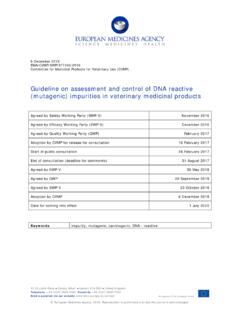Assessment And Management Of Genotoxic
Found 4 free book(s)Risk Assessment and Management of Genotoxic Impurities …
www.nihs.go.jpGenotoxic Impurities The focus of this guideline is on DNA reactive substances which can be detected by Ames assay. Application of Threshold of Toxicological Concern (TTC) to control genotoxic impurities. Risk assessment for patients and healthy volunteers during clinical development. Evaluation of genotoxicity of impurities using the
Guideline on assessment and control of DNA reactive ...
www.ema.europa.euof toxicological concern (TTC) for genotoxic carcinogens, resulting in an acceptable intake of 0.025 µg/kg bw/day. For target animals, the approaches to derive acceptable intakes are specified in section 8. Guideline on assessment and control of DNA reactive (mutagenic) impurities in veterinary medicinal products
February 2018 - World Health Organization
www.who.intlivestock feeding and management, and creating general awareness about personal protection, are some of the ways in which national authorities can help to control aflatoxins. WHO supports countries in controlling aflatoxins WHO, in collaboration with FAO, evaluates the science and develops risk assessments to define safe exposure levels.
Technical Fact Sheet – 1,4-Dioxane - US EPA
www.epa.govThe cancer risk assessment for 1,4-dioxane is based on an oral slope factor of 0.1 mg/kg/day and the drinking water unit risk is 2.9 x 10-6 micrograms per liter (µg/L) (EPA IRIS 2013). EPA risk assessments indicate that the drinking water concentration representing a 1 x 10-6 cancer risk level for 1,4-dioxane is 0.35 µg/L (EPA IRIS 2013).



